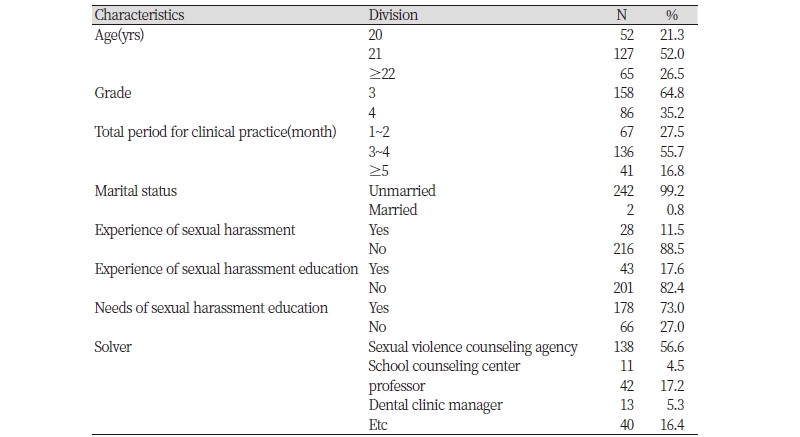Abstract
Objectives: The purpose of this study was to contribute to the provision of a safe practice environment and practical sexual harassment prevention education for dental hygiene students who practice clinically. Methods: A total of 260 students with experience in clinical practice at dental hygiene colleges and universities in Gwangju and Jeonnam was included in this study. From May 1, 2018 to June 30, 2018, subjects were surveyed about sexual harassment experience, sexual harassment related information, self-esteem, and self-assertiveness. Statistical analysis was performed by frequency analysis, independent t-test, Mann-Whitney test, one way ANOVA, Pearson’s correlation analysis, and multiple regression analysis. Results: In the sexual harassment survey revealed that 64.3% of offenders were patients and 50.0% of the offenders were in their 40s. A total of 78.6% of the offenders reported harassment in hospital type “dental clinics.” Most respondents disclosed that “I did not do anything” (60.7%). Psychologically, 75.0% felt “shame and insult.” Self-esteem was high in the fourth grade (3.68). Self-esteem and self-assertiveness were higher among those with no sexual harassment experiences (131.77 and 132.81, respectively; p<0.05). Correlation analysis indicated that self-esteem and self-assertiveness were correlated (r=0.509, p<0.01). Factors influencing the perception of sexual harassment include: three to four months of clinical practice (β=0.361), experience of sexual harassment (β=-0.551), and self-esteem (β=0.503). Conclusions: It is necessary to provide systematic and diverse information to address sexual harassment. A proper perception of what constitute sexual harassment in clinical practice is also relevant. Furthermore, practical sexual harassment prevention education program should be developed and implemented.
Figures & Tables

Table 1. The general characteristics of the subjects


